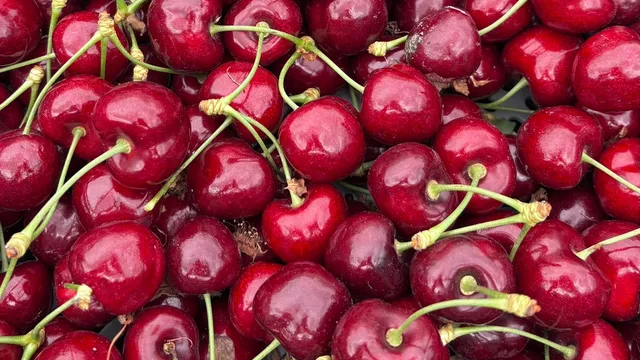
British cherry harvest hits record yield as season extends
2025-06-27 08:02- British cherry growers expect a yield of 8,000 tonnes due to favorable weather.
- The growing season has doubled to 10 weeks compared to five years ago.
- Innovations in farming techniques are revitalizing the cherry industry in the UK.
Express your sentiment!
Insights
In the UK, growers are predicting a record cherry harvest this year, with an estimated yield of 8,000 tonnes. This anticipated increase is primarily attributed to the sunny spring weather, which has contributed to better fruit quality. British cherries, which have been sampled and found to be bigger, sweeter, and juicier, are set to be exclusively sold in Tesco stores starting from early July of this year. The supermarket aims to meet summer demand solely with British produce, made possible by favorable growing conditions and an early start to the season. The cherry season has transformed significantly over the past few years, with the expected duration now spanning approximately 10 weeks, twice as long as it was five years ago. This extended season results from advancements such as the introduction of dwarf root stock and new tree varieties suitable for the UK's climate. The newer methods allow producers to cultivate cherries in plastic tunnels, creating a Mediterranean-like microclimate that safeguards the fruit from unpredictable British weather. This innovative approach enables growers to enhance both the yield and quality of cherries. As cherry farmers continue to adapt their practices, newer varieties are being introduced to enhance the growing season. Sweet Aryana and Grace Star are among the early-season varieties being cultivated, while later-season types like Kir Rosso aim to prolong the cherry harvest by an extra 10 days. This strategic investment in newer cherry varieties is expected to improve both the quality and taste of British cherries, which are increasingly popular among consumers. Furthermore, growers are utilizing innovative storage solutions to improve shelf life, allowing consumers to enjoy high-quality cherries for a more extended period. Additionally, despite the weather's inherent influence on cherry production, this year’s favorable growing conditions provide optimism for growers. Historically, when cherry production has been affected by excessive rain or humidity, quality has suffered. However, this year’s favorable forecasts suggest that the cherry industry is on a positive trajectory with a promising harvest of delicious fruit. Overall, the advancements in cherry farming techniques have led to a remarkable resurgence in the UK cherry industry, reflecting a commitment to producing high-quality cherries that meet consumer demand.
Contexts
Weather conditions significantly impact cherry production, which is critical for the enjoyment of cherries both fresh and in various culinary applications. The growth and fruiting cycles of cherry trees are closely tied to seasonal weather patterns, particularly temperature and precipitation. Cherry trees require a specific range of temperatures during different growth stages; for instance, a chilling period of cold weather is essential for dormancy break in early spring. If winter temperatures are too high, trees may emerge from dormancy too soon, increasing vulnerability to late frosts that can severely damage blossoms and reduce fruit yields. Conversely, adequate chilling hours during winter, generally between 32°F and 45°F (0°C to 7°C), contribute to better flowering and fruiting in the spring, leading to more robust harvests. In addition to temperature, the amount and distribution of rainfall throughout the growing season are crucial. Cherries require a consistent supply of moisture, especially during key growth stages when fruit set occurs. Too little rain can lead to drought stress, causing poor fruit development and smaller yields. On the other hand, excessive rainfall may result in waterlogged soils, which can lead to root diseases and impact tree health negatively. Moreover, rainfall during the harvest season can raise the risk of fruit splitting, which lowers the quality and marketability of cherries. Growers need to monitor and manage irrigation carefully to ensure that cherry trees receive sufficient water without over-saturating the soil. Wind also plays a role in cherry production; strong winds can damage blossoms and branches, leading to a decrease in overall fruit set. In addition, wind can influence the microclimate around the trees, affecting temperatures and humidity levels which could harm the flowering process. Additionally, extreme weather events, such as hailstorms or abrupt shifts in temperature, can severely impact cherry production. Hail can physically damage fruit and trees, while sudden temperature fluctuations can create stress conditions that surrounding trees may not be able to adapt to. As climate change progresses, these extreme weather events are becoming more frequent and intense, raising concerns for growers about the sustainability of cherry production in the future. In summary, the relationship between weather and cherry production is complex and multifaceted. Growers must adapt to these changing weather patterns, employing various agricultural practices to mitigate risks associated with weather fluctuations. These practices may include selecting climate-resilient cherry varieties, utilizing protective structures, and implementing effective irrigation systems. Understanding the effects of weather on cherry production is critical to maintain quality fruit output and secure the livelihood of cherry farmers. Continuous research into the interplay between weather conditions and cherry yield will advance the field and assist in mitigating the challenges posed by climatic variations.